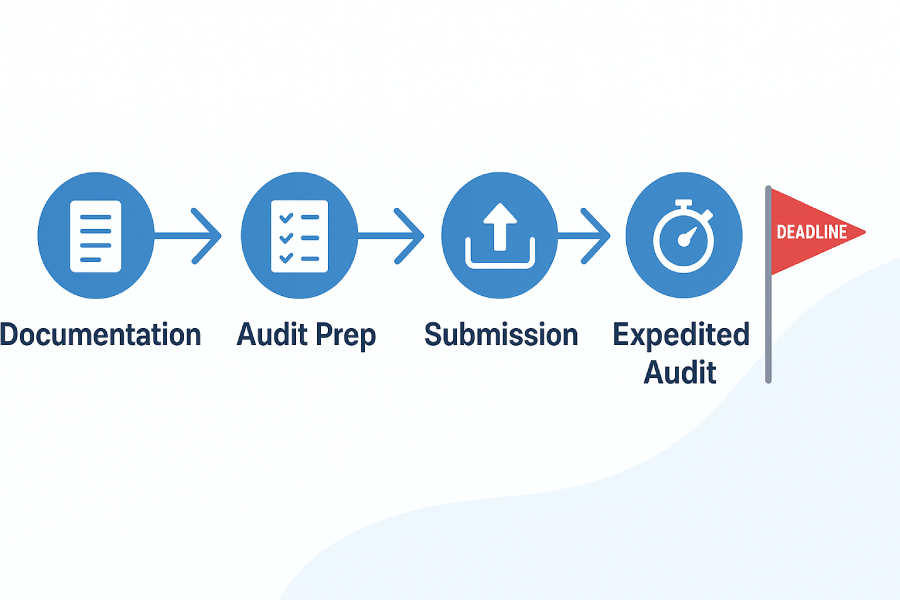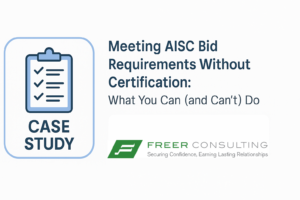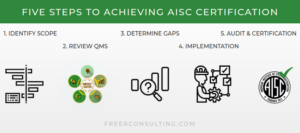You’re on or Bidding on a Project That Requires AISC Certification
You’re preparing to bid, or you’ve already taken on a project, and AISC certification is listed as a requirement. If your company isn’t certified yet, that can introduce some real pressure.
This isn’t an uncommon situation. We frequently work with teams that are fully capable of doing the work, but need to meet certification requirements under a defined timeline.
AISC certification is more than a formality, it’s a recognized standard of quality, and rightly so. But it’s also a process that involves planning, internal alignment, documentation, and coordination with AISC’s own schedule.
If you’re up against a deadline, the goal isn’t to rush, it’s to move efficiently, avoid delays, and approach the process with clarity. The following article outlines where time is typically gained or lost, what’s realistically possible, and how to keep the certification effort aligned with your project timeline.
AISC Timelines: What’s Published vs. What’s Real
The American Institute of Steel Construction outlines a certification process that typically takes seven to eight months from start to finish. That estimate includes the full cycle: application, documentation review, scheduling, and the external on-site audit.
That timeline is accurate, but only as a general reference.
In practice, the total duration depends on several variables, most importantly, implementation which is not factored into the estimate. Some companies move faster through implementation because they already have mature internal systems. Others need more time to develop or formalize documentation, assign internal responsibilities, or work through training before submitting their application.
There’s also the matter of scheduling. Once a company submits its application, the timing of the audit is subject to AISC’s availability and is not something any outside party controls. There is always the option paying AISC an expedite fee to priortize the application.
It’s important to approach the process with a realistic view of what you can influence:
- Your internal readiness and responsiveness
- How quickly your documentation can be brought into alignment
- How consistently your processes are followed in practice
Understanding where you are on those points can help you move forward without unnecessary delays and without relying on assumptions that don’t reflect your actual situation.
Expedited AISC Certification: What You Need to Know
Facing a tight project deadline? Some companies opt to pay an expedite fee to AISC in order to prioritize their audit scheduling — guaranteeing that the onsite audit is scheduled within 60 days of documentation approval.
- Expedited review doesn’t shorten the early stages – You still need to complete the application, eligibility review, and documentation review, which can take up to 5 months if there are delays.
- Documentation must be near-perfect – If you expedite but your system isn’t fully compliant, findings or revisions may still slow things down.
- You’ll need to move fast internally – Expedite efforts require weekly meetings, fast decision-making, and streamlined implementation.
Real-world insight: Some clients who expedited had audits scheduled ~2.5 months after submission – but final certification still took several more months due to AISC’s review process.
Bottom line: Expediting can help if your system is truly ready. If you’re still building your QMS, your biggest gains come from moving efficiently – not skipping steps.
Contact us to see if expediting makes sense for your situation
Where Projects Gain or Lose Time
The difference between a smooth certification process and a delayed one often comes down to how the early stages are handled. Most of the time gained or lost happens well before the AISC audit is scheduled.
Some of the most common areas where projects lose time include:
- Unclear internal ownership – Without defined process owners, decision-making can stall and follow-up tasks fall through the cracks.
- Delayed document gathering or review – Even companies with good practices in place may take weeks longer than expected to produce the necessary documentation or approve revisions.
- Underestimating the scope – Teams may assume certification is mainly paperwork, only to realize that aligning procedures and training takes more coordination than expected.
- Waiting too long to engage support – The earlier you start with experienced guidance, the more flexibility you retain. Starting late limits your ability to adapt if something unexpected comes up.
On the other hand, companies that move efficiently tend to:
- Identify a dedicated point of contact for certification work
- Make time early to review and align existing documentation
- Stay responsive during review cycles and decision points
- Set internal expectations clearly, both for workload and for timeline
These aren’t shortcuts, they’re practical steps that reduce friction. And they can make the difference between meeting a project deadline and missing the opportunity entirely.
What an Efficient Certification Process Looks Like
While there’s no one-size-fits-all timeline for AISC certification, in our experience, companies that move efficiently often follow a pattern. While exact durations vary based on internal readiness and the scope of operations, a streamlined process typically includes:
- Initial Discovery and Scoping
Define the scope of certification, assign internal process owners, and identify existing documentation that can be leveraged. This stage sets the foundation and prevents rework later. - Documentation Development and Alignment
Draft or revise procedures to align with AISC requirements. This includes implementing or updating the quality manual, training plans, and control processes. Regular check-ins help keep this phase on track. - Training and Internal Audit Preparation
Train key personnel on documented procedures and conduct a full internal audit. Any gaps identified here can be addressed before submission. - Application and Pre-Audit Review
Finalize documentation, gather sample records, complete the application to AISC, and ensure the system is functioning as intended. At this point, the timeline becomes dependent on AISC’s audit scheduling. - External Audit and Certification Decision
Once the audit is scheduled, the focus shifts to readiness for the on-site assessment. The timing of this step is controlled by AISC, not the applicant or consultant.
This structure isn’t guaranteed to compress the full process, especially with external audit timing outside of your control, but it does help your team make consistent, forward progress. The companies that succeed under time pressure aren’t rushing. They’re just organized, responsive, and guided by a clear plan.
Planning with a Bid Deadline in Mind
If your company is facing a fixed deadline, whether it’s for a bid, a contract award, or a client requirement, the most important step is to start planning backward from that date.
Working with AISC’s estimated timeline of seven to eight months is a good baseline, but the actual time required can vary depending on your internal readiness and how quickly you can move through implementation.
To plan effectively, consider:
- What your client or general contractor actually requires
Do they need full certification by the bid date, or is evidence of a certification path sufficient? In some cases, a clear plan and demonstrated progress may satisfy the requirement in the short term. - How long internal preparation will realistically take
If you don’t have documentation or procedures in place, you’ll need time to create and align them, not just to pass the audit, but to operate under a system that reflects your actual practices. - What time is needed for training and internal audit
Personnel need to be familiar with the documented system, and internal audits must be conducted and corrected before you’re ready for the external assessment. - AISC’s scheduling lead time
Once you submit your application, scheduling the on-site audit is handled by AISC, and timing can vary depending on demand and availability.
The key is to avoid relying on best-case assumptions. If your deadline is six months out, and AISC may need eight weeks just to schedule an audit, that leaves little room for delays in earlier phases.
A structured, realistic plan, grounded in your actual starting point, is your best tool for moving forward with confidence.
How to Know If You’re in a Good Position to Start
Before beginning the certification process, it’s worth taking a step back and assessing your current level of readiness. AISC certification is achievable under tight timelines, but only if your internal systems and team are positioned to move efficiently.
Here are a few questions to help you gauge where you stand:
- Do you already have written procedures or a basic quality manual in place?
- Are your production and quality processes consistent and documented?
- Can you assign a dedicated internal lead to manage certification tasks?
- Are senior decision-makers aligned on the timeline and required commitment?
- Do you have capacity to participate in weekly reviews or implementation work over the next several months?
If you can answer yes to most of these, your company is likely in a good position to move forward without significant delays. If not, it doesn’t mean you can’t proceed, it just means the timeline will need to reflect additional groundwork.
Establishing clarity early on, around resources, responsibilities, and expectations, is one of the most effective ways to keep your project moving on schedule.
What You Can (and Can’t) Control
Part of managing an AISC certification timeline effectively is knowing which parts of the process are within your control, and which are not.
What you can influence:
- The clarity and completeness of your documentation
- The pace of your internal decision-making and reviews
- Responsiveness during implementation
- The quality and readiness of your internal audit
What you cannot influence:
- AISC’s timeline for application review and audit scheduling
- The auditor’s availability or assessment timeline once scheduled
- The certification decision process itself
Focusing on what you can control, and addressing it with a well-organized, proactive approach, helps avoid unnecessary delays and keeps your certification effort aligned with your business goals.
Working with a consulting partner can’t eliminate uncertainty, but it can reduce friction, flag risks early, and keep the project moving at a consistent pace.
How Freer Helps You Move Efficiently
We work with companies at all stages of readiness- from those starting with no documentation to those with established systems looking for alignment and guidance.
What makes the process efficient isn’t just speed- it’s structure.
Our approach is built to reduce friction, avoid rework, and keep forward momentum. That includes:
- A clear scoping process at the start
- Templates and examples tailored to your type of operation
- Weekly progress checkpoints
- Guidance through internal audits and corrective actions
- Support with the AISC application and audit preparation
We know how to help your team focus on what matters and how to get organized around your deadline.
Next Steps
If you’re working toward a bid or contract that requires AISC certification, the most important thing you can do right now is start planning.
You don’t need to have all the answers in place, but the earlier you define your path, the more flexibility you’ll have to meet your deadline without unnecessary stress.
We’ll help you assess where you are and what’s realistic based on your timeline
AISC certification is a meaningful achievement. With the right structure, it doesn’t have to be overwhelming, even under pressure.








